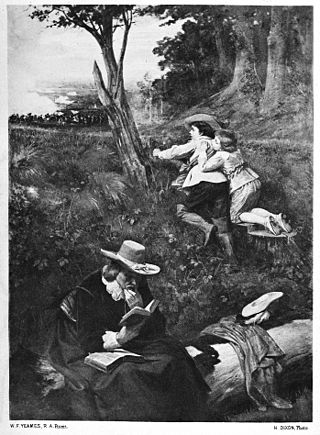
The Battle of Edgehill was a pitched battle of the First English Civil War. It was fought near Edge Hill and Kineton in southern Warwickshire on Sunday, 23 October 1642.

Aylesbury is the county town of Buckinghamshire, South East England. It is home to the Roald Dahl Children's Gallery and the Waterside Theatre. It is located in central Buckinghamshire, midway between High Wycombe and Milton Keynes.

Hardwick is both a village and a civil parish within the Aylesbury Vale district in Buckinghamshire, England. It is in the Aylesbury Vale, about four miles north of Aylesbury.

Thame is a market town and civil parish in Oxfordshire, about 13 miles (21 km) east of the city of Oxford and 10 miles (16 km) southwest of Aylesbury. It derives its name from the River Thame which flows along the north side of the town and forms part of the county border with Buckinghamshire. The parish includes the hamlet of Moreton south of the town. The 2011 Census recorded the parish's population as 11,561. Thame was founded in the Anglo-Saxon era and was in the kingdom of Wessex.
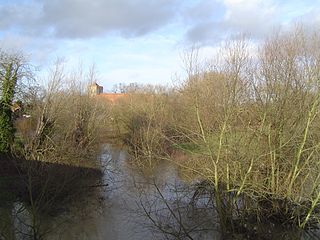
The River Thame is a river in Southern England. A tributary of the River Thames, the river runs generally south-westward for about 40 mi (64 km) from its source above the Buckinghamshire town of Aylesbury to the Thames in south-east Oxfordshire.

Although the name Buckinghamshire is Anglo Saxon in origin meaning The district (scire) of Bucca's home the name has only been recorded since about the 12th century. The historic county itself has been in existence since it was a subdivision of the kingdom of Wessex in the 10th century. It was formed out of about 200 communities that could between them fund a castle in Buckingham, to defend against invading Danes.
There has been a Lord Lieutenant of Buckinghamshire almost continuously since the position was created by King Henry VIII in 1535. The only exception to this was the English Civil War and English Interregnum between 1643 and 1660 when there was no king to support the Lieutenancy. The following list consists of all known holders of the position: earlier records have been lost and so a complete list is not possible. Since 1702, all Lord Lieutenants have also been Custos Rotulorum of Buckinghamshire.

Aylesbury is a constituency represented in the House of Commons of the UK Parliament.
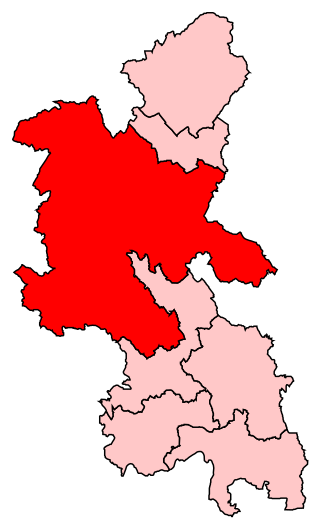
Buckingham was a constituency that was last represented in the House of Commons of the UK Parliament by Greg Smith, a Conservative.
The Aylesbury Vale Academy, formerly Quarrendon School, was Buckinghamshire's first Academy. It is a Church of England Academy with the Anglican Diocese of Oxford as the primary sponsor and Buckinghamshire Council as a co-sponsor.

The Battle of Turnham Green took place on 13 November 1642 near the village of Turnham Green, at the end of the first campaigning season of the First English Civil War. The battle resulted in a standoff between the forces of King Charles I and the much larger Parliamentarian army under the command of the Earl of Essex. In blocking the Royalist army's way to London immediately, however, the Parliamentarians gained an important strategic victory as the standoff forced Charles and his army to retreat to Oxford for secure winter quarters.

Arthur Goodwin of Upper Winchendon, Buckinghamshire was an English lawyer and politician who sat in the House of Commons at various times between 1621 and 1643. He supported the Parliamentary cause during the English Civil War.

The battle of Powick Bridge was a skirmish fought on 23 September 1642 south of Worcester, England, during the First English Civil War. It was the first engagement between elements of the principal field armies of the Royalists and Parliamentarians. Sir John Byron was escorting a Royalist convoy of valuables from Oxford to King Charles's army in Shrewsbury and, worried about the proximity of the Parliamentarians, took refuge in Worcester on 16 September to await reinforcements. The Royalists despatched a force commanded by Prince Rupert. Meanwhile, the Parliamentarians sent a detachment, under Colonel John Brown, to try to capture the convoy. Each force consisted of around 1,000 mounted troops, a mix of cavalry and dragoons.
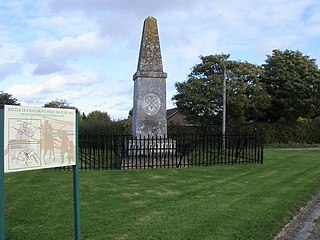
The Battle of Chalgrove Field took place on 18 June 1643, during the First English Civil War, near Chalgrove, Oxfordshire. It is now best remembered for the death of John Hampden, who was wounded in the shoulder during the battle and died six days later.

Holman's Bridge is a brick-built bridge on the A413 to the north of Aylesbury in Buckinghamshire, England. It is where the A413 road crosses the River Thame. Aylesbury's first Charter of Incorporation in 1554 marked Holman's Bridge as the northernmost boundary of the town.
The Battle of Brentford was a small pitched battle which took place on 12 November 1642 in Brentford, Middlesex, between a detachment of the Royalist army under the command of Prince Rupert, and two infantry regiments of Parliamentarians with some horse in support. The result was a victory for the Royalists.

Cornwall played a significant role in the English Civil War, being a Royalist enclave in the generally Parliamentarian south-west.

The Storming of Bristol took place from 23 to 26 July 1643, during the First English Civil War. The Royalist army under Prince Rupert captured the important port of Bristol from its weakened Parliamentarian garrison. The city remained under Royalist control until the second siege of Bristol in September 1645.

Buckingham Park is a suburban residential neighbourhood contiguous with the north-west edge of Aylesbury, Buckinghamshire, England. It is currently the location of major housing developments on two sites known originally as Weedon Hill and Berryfields. Buckingham Park is also the name of the civil parish, part of Aylesbury Vale District Authority. The neighbourhood is close to the River Thame.
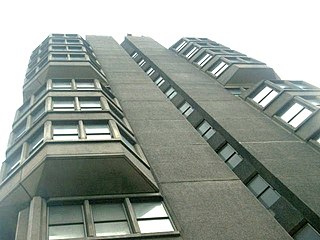
County Hall is a high-rise tower block in Walton Street in Aylesbury, in the county of Buckinghamshire in England. It was built to house the former Buckinghamshire County Council. Following local government reorganisation in 2020 the building is now owned by Buckinghamshire Council. County Hall continues to be used as offices by the new council, but meetings of the council are held at The Gatehouse in Aylesbury, the former offices of Aylesbury Vale District Council.


















